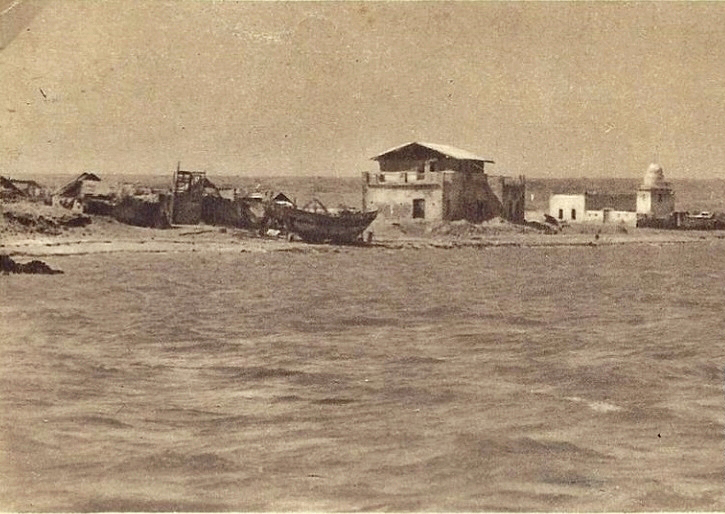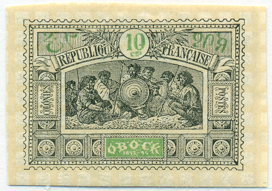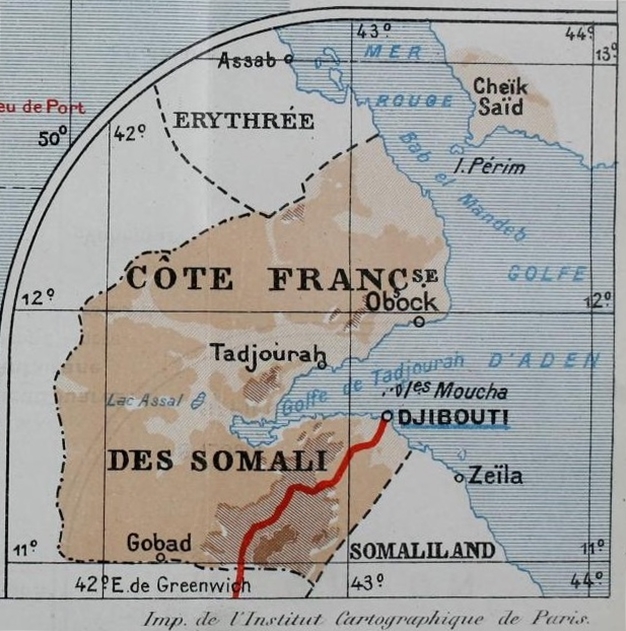ALBUM – View my Obock Album
Fast Facts
Region: East Africa
Group: French Colony
Classification: Colonies
Prior Regime: Sultanate of Obock
Key Dates:
1862 – French purchased port of Obock from the Sultan of Obock
1881 – French establish a Coal refill station for steam ships
1884 – French establish Colony of Obock
1888 – French establish Colony of Cote Francaise des Somalis (French Somaliland)
1896 – French moves capital of French Somaliland to Djibouti
Following Regime: Djibouti
Scott Catalogue: (Obock) 1-64, J1-J18
Pick Catalogue: none
History

The French did little to develop the port until 1881 when Pierre Arnoux, a French trader, established a important station to acquire coal from African suppliers and provide it to French steamships in the region. Prior to this, French ships had to buy coal from the British Port of Aden, which put France in a difficult position, especially as their relationship with the British was extremely tenuous.
As the French continued to expand their influence in the region, additional traders arrived and set up business. Obock quickly became an important port in the region, and in 1884 it officially became the capital of the Territory of Obock and the Protectorate of Tadjoura.
As the French continued to expand their interests on the Horn of Africa, they realized that Obock was not the most strategic location. Located on the more exposed northern part of the Gulf of Tadjoura, and being far from important trading routes in the region, the French made the strategic decision in 1888 to develop the port of Djibouti on the opposite side of the Gulf.
In 1892, the administrative capital of the colony was moved from Obock to Djibouti, and on May 20, 1896, Djibouti officially became the capital of the Colony of Cote Francaise des Somalis (French Somaliland), consolidating the Obock territory and the surrounding protectorates.
From from this point, the port of Obock dwindled in importance and population.
Stamps
 For being such a small colony for a short period of time, Obock has an interesting philatelic history, as well as some very beautiful stamps to collect. Initially, stamps of the French Colonies were used for postage in Obock, however beginning in 1892, Obock begin hand stamping “OBOCK” on the French colony stamps as provisional issues until proper stamps arrived from Paris. There were two types of hand stamped overprints on the provisional stamps, one where “OBOCK” was printed in an arc, and the other in a straight line. All of these issues have been extensively forged. These overprints were applied to 20 regular issue stamps, 11 surcharged stamps and 18 postage due stamps.
For being such a small colony for a short period of time, Obock has an interesting philatelic history, as well as some very beautiful stamps to collect. Initially, stamps of the French Colonies were used for postage in Obock, however beginning in 1892, Obock begin hand stamping “OBOCK” on the French colony stamps as provisional issues until proper stamps arrived from Paris. There were two types of hand stamped overprints on the provisional stamps, one where “OBOCK” was printed in an arc, and the other in a straight line. All of these issues have been extensively forged. These overprints were applied to 20 regular issue stamps, 11 surcharged stamps and 18 postage due stamps.
In Nov 1892, France issued the Navigation and Commerce series for all French colonial territories. The common design stamp was printed in a key stamp process, where the colony name was printed in a rectangular cartouche at the bottom of a common design for all colonies. Stamps of Obock arrived in Dec, 1892.
In 1893 – 1894, Obock began to issue some of the most beautiful stamps of the era. In 1893, the colony issued 2 imperforate triangle stamps in higher denominations (2fr and 5fr). The stamps were printed on quadrille paper, and featured an image of a camel and rider. In 1894, Obock issued a set of 13 rectangular stamps, also on quadrille paper, picturing a group of Somali Warriors. An additional five higher denomination stamps (2fr – 50fr) were issued as triangle stamps, also featuring Somali Warriors, but on camels.
In 1884 the main post office was moved to Djibouti, although Obock maintained a branch office. Stamps of Obock were superseded by those issued for the French Somali Coast in 1902.
Banknotes
French and British India currency were used in Obock.
Links
Obock at Wikipedia
Stamps – The Era of the French Colonial Group Type: Obock, Djibouti and the Somali Coast by Ed Grabowski
Obock at BigBlue 1840-1940 Blog
Obock at Stamp World History






Hi Michael
Hope all is well with you.
I enjoyed reading your smooth narrative of the changing fortunes of Obock. Clearly, it shows the value of location, location….oops, a better location was found (Dijbouti)…sorry Obock. 😉
Ed Grabowski’s article was great!
The 1894 large format rectangular “Somali Warriors” and triangular “Camel and Rider” issue is indeed attractive. But a “sea change” for stamp collectors was occurring. Governments were now aware how to extract money from the collector. ( The U.S. 1893 Columbian Exposition issue is another case in point.)
All the best!
Jim Jackson
Note: BB link doesn’t work for me- should be ….
http://bigblue1840-1940.blogspot.com/2014/10/ClassicStampsofObock.html
Thanks Jim, as usual I enjoy your comments. Obock indeed a sad little colony, and it never had a very large population either. I do like the stamps though, even as the pretty ones were designed for the philatelic trade, as you indicated.
Fixed the link, it works now.
Michael